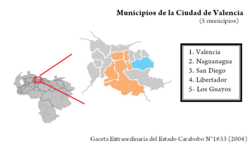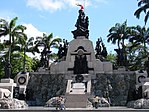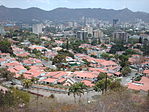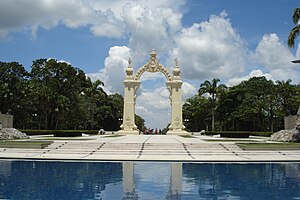Valencia, Carabobo, Venezuela
| Valencia | |||||||||||
|---|---|---|---|---|---|---|---|---|---|---|---|
| Nuesta Señora de la Asunción de la Nueva Valencia del Rey |
|||||||||||
|
|||||||||||
|
|||||||||||
| Nickname(s): Capital industrial de Venezuela, La pequeña Detroit |
|||||||||||
 |
|||||||||||
| Coordinates: 10°11′N 68°00′W / 10.183°N 68.000°WCoordinates: 10°11′N 68°00′W / 10.183°N 68.000°W | |||||||||||
| Country |
|
||||||||||
| State | Carabobo | ||||||||||
| Municipality |
Valencia Libertador Los Guayos Naguanagua San Diego |
||||||||||
| Founded | March 25, 1555 | ||||||||||
| Area | |||||||||||
| • Total | 1,578 km2 (609 sq mi) | ||||||||||
| Elevation | 520 m (1,710 ft) | ||||||||||
| Population (2010) | |||||||||||
| • Total | 1,827,165 | ||||||||||
| • Density | 1,475/km2 (3,820/sq mi) | ||||||||||
| Demonym(s) | Valenciano(a) | ||||||||||
| Time zone | VST (UTC– 4:30) | ||||||||||
| • Summer (DST) | not observed (UTC– 4:30) | ||||||||||
| Postal code | 2001 | ||||||||||
| Area code(s) | 0241 | ||||||||||
| Website | alcaldiadevalencia.gov.ve | ||||||||||
| ^* The area and population figures are for the municipality | |||||||||||
Valencia (Spanish pronunciation: [baˈlensja]) is the capital city of Carabobo State, and the third largest city of Venezuela.
The city is an economic hub that contains Venezuela's top industries and manufacturing companies. The population of Valencia and the nearby metropolitan area reached 1,827,165 in 2010, and it is expected to grow dramatically in the years to come. Caracas lies some 172 kilometres (107 miles) away to the east.
The area was already inhabited in the fourth millennium BC. The inhabitants were mainly hunters and gatherers who might have already developed some elementary forms of agriculture. Between AD 200 and 1000 an important settlement was formed close to Lake Valencia.
Around the year 1000, waves of migration started to come from the Orinoco river area, probably arriving along the Pao river. The fusion of previous settlements with these new populations gave rise to the Vacencioide culture.
People in the area belonged mostly to Arawak groups. They were hunters and gatherers who also fished and grew maize and cotton. Their houses were built on artificial mounds in valleys that were often flooded by water from Lake Valencia.
Archaeologists have found mostly pottery from that time. Valencia was founded by Captain Alonso Díaz Moreno on March 25, 1555 – as the locals are proud of reminding visitors, eight years before Caracas. It was the first Spanish settlement in central Venezuela and its official name was Nuestra Señora de la Asunción de Nueva Valencia del Rey. It was named after Valencia de Don Juan, Province of León, Spain. The encomiendas put the Indians living in the region under the control of the Spanish settlers. They started to displace the native population from the most fertile land, but they also started intermarrying with them.
Spanish conquistador Lope de Aguirre entered the city in 1561. In 1677 it was raided by French pirates, who burnt down its City Hall, thus destroying many very important documents about the early settlement of Venezuela. The German scientist Alexander von Humboldt visited the city on his trip through the Americas. He reported that at the time of his visit the city had around 6000 to 7000 inhabitants. On June 24, 1821 the battle of Carabobo was fought on the outskirts of the city, sealing the independence of Venezuela from imperial Spanish rule. In 1830 Valencia became capital of Venezuela after it separated from the Great Colombia. It stopped being capital soon thereafter and became once more the seat of the national government in 1858 after the Monagas was toppled and the March Revolution took place. On November 15, 1892 the University of Valencia, future University of Carabobo, was founded. When dictator Juan Vicente Gómez died in 1935, Nueva Valencia del Rey was a small city. The oil revenues and industrialization that came along lead to a population explosion. Many immigrants, firstly from Europe and increasingly then from other Latin American countries, chose Nueva Valencia del Rey as the place to live in Venezuela.
...
Wikipedia











